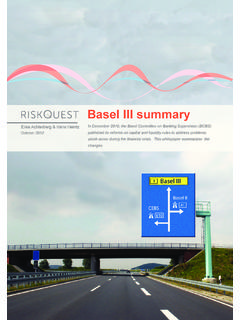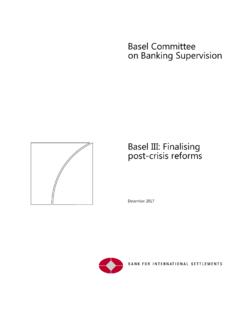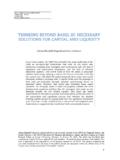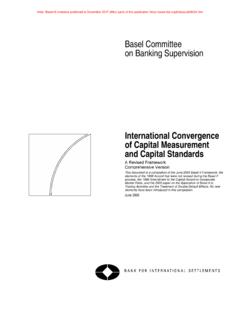Transcription of Basel III - Tilburg University
1 Basel III. Building blocks of new regulation Preface: Stress-resistant According to Webster's dictionary, a stress-resistant person is able to bear high ten- sion and pressure from the environment without a problem. This also holds for the Rabobank risk managers. Theirs is the important task to map and monitor the risks of banking (because to bank is to take risks) and to warn if the bank's risk appetite is exceeded. In the second half of July the relevant European banks were subjected to a stress test by the Central European Banking Supervisor (CEBS); Rabobank performed exemplary.
2 Of course, no other outcome could have been forthcoming, given the low risk profile the bank prides itself on. Still, I am glad that our risk managers regularly test the foun- dations of the bank using more severe assumptions than what the European Regu- lator handed to the European Banks. A stress-test should never become a relax-test! Meanwhile we are confronted with increasing solvability requirements and new liqui- dity requirements. The initial proposals from the Basel committee, also known under the name of Basel III, deservedly met with lots of resistance.
3 Banking would become all but impossible under these types of rules. However, now that the proposals have been adjusted, we at Rabobank have no problems abiding by them. In other words, we feel that these are reasonable proposals, doing justice to the lessons learned during the credit crisis. Ultimately, they are meant to make banks more stress-resilient. This implies larger and more solid capital buffers to boost solvability. At the moment it looks like Rabobank will be able to meet the core capital ratio requirements from the very start, even though they are planned to be phased in from 2013 to 2019.
4 That the requirements will take some time to come to full force doesn't say much; investors will immediately start judging banks based on the full 2019 requirements. Moreover, we will need to top off' our capital given our triple-A ambitions. This top rating will be very necessary in the future to acquire the additional funding that is needed to comply to the new liquidity requirements. In short: There are ample challenges ahead. Tightened requirements also mean that we accurately have to steer the headroom that remains for expansion.
5 Even for Ra- bobank there are limits to growth. This is not a bad thing per se, as long as we can continue to live up to our ultimate purpose to facilitate our clients. Ample food for thought' I would say. Thus, I wish you all a fascinating and fruitful conference. Bert Bruggink Why Basel III? Ever since the first proposal of the existing Basel II Capital Accord was issued, its merits and its weaknesses are discussed in the banking world. But only the recent financial crisis proved that internationally active banks still failed to fully absorb credit losses since they fell short of capital.
6 Note however that Basel II still needed to be fully im- plemented at the onset of the financial crisis. Nevertheless politicians pressured the Basel Committee on Banking Supervision (BCBS) to discuss the shortcomings of the Basel II Capital Accord and come up with possible amendments. These are now des- cribed as Basel III. In short, Basel III builds upon the existing regulatory capital framework but introduces some adjustments that are meant to reflect the lessons learned from the financial cri- sis. The final draft of Basel III will be proposed to world leaders on the G20 meeting in Seoul, in November 2010.
7 The support of G20-leaders is necessary since Basel has no regulatory role; its advice needs to be incorporated internationally, in the European directives and in national laws. This brochure wants to inform you about Basel III based on the information that is available until mid October 2010. Basel III an overview In December 2009 the initial Basel III proposal was issued for consultation. Since then the Basel Committee made some amendments and published more concrete details on the implementation phase. Basel III proposes changes in the following areas: I.
8 Definition Own Funds: Harmonization and tightening of capital instruments allowed Own Funds (I). for inclusion in own funds to calculate the Ratio (II). ratios. II. Capital buffers: Increasing the explicit mini RWA (III). mum ratios of Tier 1 common equity, Tier 1. capital and total capital to risk weighted as- sets. III. Risk Coverage : Strengthening the capital requirements (hence RWA) for, market risk, securitisations and counterparty credit risk arising from derivative transacti- ons. IV. Leverage ratio: Introducing a constraint on leverage based on gross exposure as a non-risk weighted backstop'.
9 V. Liquidity requirements: Implementation of a short term and a long term liquidity ratio that are internationally consistent. The proposed changes will be subsequently discussed in this brochure. Summarized altogether, the changes lead to higher minimum standards of capital ratios that are increasing during the transition period from 2013 to 2019. I. Definition of own funds Basel I introduced the concept that banks should have enough own funds to cover their risks. Basel II did change the view on risks but only slightly adjusted the defini- tion of own funds.
10 It should be noted that this definition of own funds significantly differs from that of IFRS equity. The existing own funds definition under Basel II has several flaws: there are large inconsistencies across jurisdictions, there is lack of loss absorbency of some capital components and there is no harmonised list of regula- tory adjustments ( deductions). As a consequence, it has been possible for some banks to display strong solvency ratios with limited tangible common equity. In order to fight these shortcomings, the Basel Committee announced several measures in order to raise the quality, consistency, and transparency of own funds.






